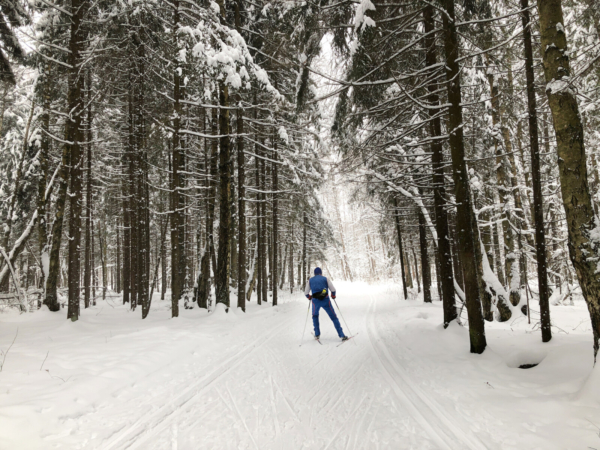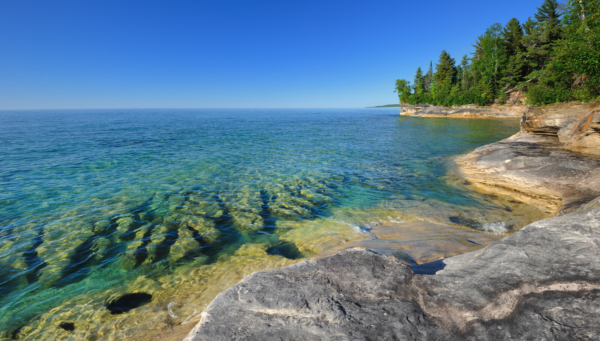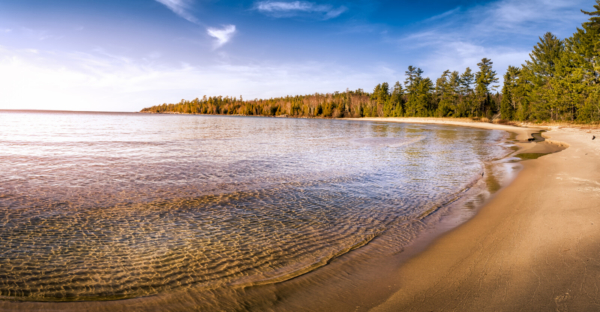I can only give a personal perspective: I love it. When people gather, clothes are informal and the talk is of friends, trails, fly fishing, kayaks, skiing, wind directions and lake temperatures, rock climbing, biking, camping, and outdoor sports. People who seek the openness of lakes you can’t see across stay here.
 One of my favorite seasons is the winter. I love cross-country skiing (especially at night on a lighted track or just in the moonlight) and enjoy snowshoeing. Winter warms the heart with its crystal beauty, and at the end of a day on the trail or the ski slopes, there is nothing like coming home to a wood stove and sharing experiences with your friends and loved ones.
One of my favorite seasons is the winter. I love cross-country skiing (especially at night on a lighted track or just in the moonlight) and enjoy snowshoeing. Winter warms the heart with its crystal beauty, and at the end of a day on the trail or the ski slopes, there is nothing like coming home to a wood stove and sharing experiences with your friends and loved ones.
August at the Lake holds its own with any place on earth. By then, the bugs are mostly gone, and after Labor Day, comes the spectacular color and dramatic weather of a Michigan fall. We can get snow in early October, but it’s a welcome tease of the season coming — a time to settle in and slow down, just a bit. November after the leaves are down but before the first snow is lovely. It shows off the landscape’s shapes and offers unique opportunities to seek out new spots usually covered in foliage or snow.
By the first of April, it seems like it should be warm, but there’s still snow on the ground. It is crusted in the afternoon by a warming sun though, which makes it a great time to be out on cross-country touring skis or snowshoes. A little later in spring come the ephemerals — spring beauties, trout lilies, Dutchman’s breeches (or French guy’s underwear, as my kids used to call them). The woods become fragrant and colorful with new life.
In June and early July, it can be buggy and you need to pick your days to be in (or get out of) the woods. When the air is dry and there is a little breeze, it is lovely. With humidity and still air the bugs chase you out of the woods and there are usually five or six days in June and July when the best thing to do is accept the inevitable and stay indoors or at least, in town.
 If the wind is right, you can often escape the bugs by staying at the Lakeshore, too. And, I (and my whole family) have an Original Bug Shirt. I find it indispensable and it has saved many camping trips that otherwise would have had us packing up and heading home.
If the wind is right, you can often escape the bugs by staying at the Lakeshore, too. And, I (and my whole family) have an Original Bug Shirt. I find it indispensable and it has saved many camping trips that otherwise would have had us packing up and heading home.
Lake Superior is primarily a rock-rimmed lake, with occasional sand beaches in the bays. Primary roads run along both shores of the U.P. so the trick to finding good property starts with locating parcels with enough depth between the highway and the lake to silence the sounds of traffic.
Inland lakes east of Marquette and Munising are sand-bottom lakes. The water is clear because the snowmelt and rainfall soaks right into the sandy ground and is filtered by the sand before the water gets to the lake. The sandy soil means the topography is rolling, shaped by the glaciers, with little or no rock. Rivers run clear. Hemingway’s Nick Adams stories were set in this country, supposedly on the Big Two-Hearted River. Actually, the artist in him couldn’t pass up the name, but his trout stream was the Fox, still one of the classic trout streams east of the Mississippi.
West of Marquette there are ancient hills that they say were once the size of the mountains in Tibet. The surfaces have worn away with erosion, glaciers and the passage of time which has exposed the deeper layers where the minerals crystallized. That is why this area has such great mineral wealth. Negaunee, a nearby old mining town, was once picked as the “richest town in the world” based on the value of the iron ore. Gold in small amounts is fairly common and you can pan for it on many streams. I’ve spent very wonderful days panning for gold with an old miner who licked – yes, licked – rocks to better understand their qualities and how they would behave when mined.

Spectacular rock faces and truly rough and majestic terrain remains. This is a country filled with waterfalls, streams, and lakes with dramatic rock outcroppings and black water lakes. The water is black (actually tea-colored) because the snowmelt and rainfall find the rock just below the surface and instead of soaking in and being filtered by sand runs through the pine needles and cedar roots, picking up the tannin that colors the water. There are muskies and northern pike under that dark water that strike with force.
I’ve been fortunate to have lived and had extended visits in a variety of beautiful places: the West Coast, the South, Yellowstone and Glacier, the Smokies and the PCT, Europe, Canadian wilderness, and everything in between. All were great places to visit or live and all had their own unique charm and hold on my heart. And — the U.P. takes the cake. There is no better place to work, make friends, raise a family, enjoy the outdoors, and live — really live.
